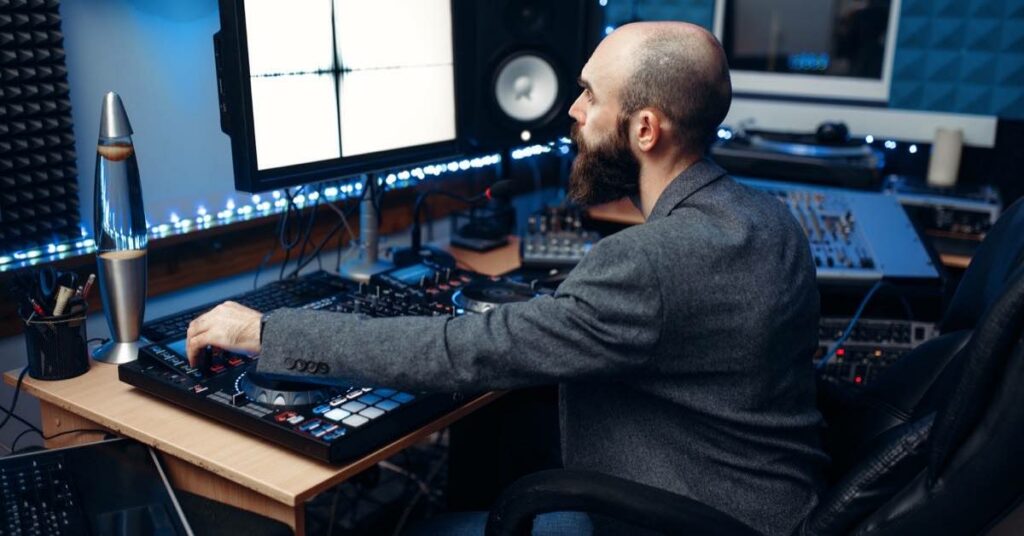Sound design plays a crucial role when creating a compelling cinematic experience that often goes unnoticed. It enhances the storytelling, creates immersive soundscapes, and adds emotional depth to the visuals. In this article, we will explore the importance of sound design in video production and its impact on the audiovisual experience.

Understanding Sound Design
In the film industry, sound design refers to the creative process of manipulating audio elements to enhance the overall narrative and aesthetics of video production. It involves the use of various audio effects, sound effects, ambience, dialogue, background music, and soundtracks to create a cohesive and impactful audio experience. Sound design is often done during post-production and requires audio engineering and mixing expertise.
Sound design is crucial in video production as it enhances storytelling, creates immersive soundscapes, and adds emotional depth to the visuals. While the visuals capture the audience’s attention, the sound design can truly engage them on a deeper level. Sound designers can highlight important moments, create tension, evoke specific emotions, and guide the viewer’s focus by carefully crafting the audio elements. This attention to detail in sound design can elevate a video production from ordinary to extraordinary.
Enhancing the Storytelling
Sound design plays a significant role in enhancing the storytelling aspect of video production. Through careful sound editing and audio synchronisation, sound designers can highlight important moments, emphasise emotions, and guide the audience’s attention. The choice of atmospheric sounds, background music, and sound effects can create a sense of realism and immerse the viewers in the narrative. By shaping the auditory elements, the sound design adds depth and dimension to the storey.
Creating Immersive Soundscapes
One of the key contributions of sound design is the creation of immersive soundscapes. By strategically placing and layering sounds, sound designers can transport the audience to different environments within the video. Whether it’s the bustling streets of a city, the serene tranquillity of nature, or the futuristic world of science fiction, the manipulation of audio allows for a more immersive and engaging experience.
The careful balance and mix of different elements enable the viewers to feel a part of the on-screen world. With sound design, the audience is no longer just passive observers; they become active participants in the audiovisual journey. The meticulous attention to detail and the artful arrangement of sounds elevate the overall quality of the production, making it more captivating and memorable.
Adding Emotional Impact
Sound design has the power to evoke strong emotions and enhance the emotional impact of video production. The right choice of background music, sound effects, and soundscapes can create a sense of tension, excitement, or melancholy, aligning with the intended mood of the scene. By manipulating the audio elements, sound designers can effectively convey the intended emotional message and elicit a deeper emotional response from the audience.
- The sound design evokes strong emotions.
- Background music, sound effects, and soundscapes set the mood
- Manipulating audio elements to convey the emotional message
The marriage of sight and sound in video production is what truly brings a storey to life. While stunning visuals are essential, the soundscape completes the immersive experience. Sound design adds depth and realism, making the viewer feel fully transported to the world within the screen. Whether it’s the rustling leaves in a serene forest or the bone-chilling footsteps in a horror film, every sound has a purpose and contributes to the overall impact of the video. Sound design is the invisible hand that guides the viewer’s emotions, leading them through the narrative and helping them connect with the characters and their journey.
- Sound design completes the immersive experience.
- Adds depth and realism
- Guides viewer’s emotions
- Connects viewer with characters and storey
Collaboration and the Creative Process
Sound design is a collaborative process that involves close interaction with the video production team. Sound designers work closely with directors, editors, and other post-production team members to ensure that the audio elements complement and enhance the visual storytelling. The creative process includes multiple stages, from initial discussions and brainstorming sessions to implementation and iterative refinement. The seamless integration of sound design into video production requires a strong understanding of the overall vision and goals of the project.
- Sound design is a collaborative process that involves close interaction with the video production team.
- Sound designers work closely with directors, editors, and other post-production team members.
- The creative process includes multiple stages, from initial discussions and brainstorming sessions to implementation and iterative refinement.
- The seamless integration of sound design requires a strong understanding of the overall vision and goals of the project.
Advancements in Audio Technology
The advancement in audio technology has revolutionised the field of sound design in video production. With sophisticated tools and software, sound designers have more control and flexibility in manipulating and enhancing audio elements. The use of spatial audio technologies enables the creation of 3D soundscapes, further immersing the audience in the audiovisual experience. As technology continues to evolve, the possibilities for creative sound design in video production are limitless.